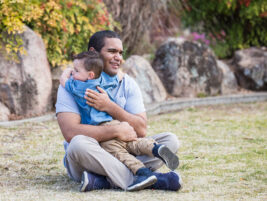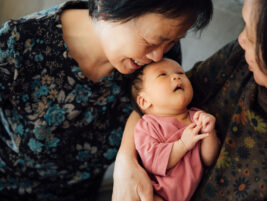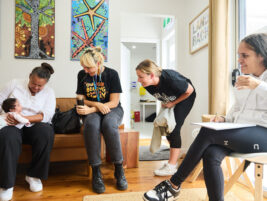The beginning of a collaboration
My collaboration with the Municipal Foundling Home of Thessaloniki (MFH), first in the position of child-psychiatrist and then as director of the Child-Psychiatry Services, starting 20 years ago, has gone over many transformations. During the first years, I was mainly asked to do child psychiatric assessments, upon the request of either the Social Services or the Home director. These referrals were very well welcomed by my team, in contrast with most of our child psychiatry colleagues, who saw them as “mainly psychosocial cases, not “real” psychopathology, therefore as cases that can be dealt by any community worker.
Psycho-social cases and child psychiatry
Here one encounters the following paradox: Those “psycho-social cases”, so highly invested by the Social/Welfare Services, are easily turned away by child psychiatry clinics. While not being interesting enough from the clinical standpoint, these same institutionalized infants have attracted scientific interest, and indeed, several famous researchers, such as Rutter and Zeanah, have studied their development. Research is definitely important, but we need to be aware of the danger embedded in measurements and concepts devoid of affective experience and connotations.
On one hand, these case stories are interesting at many levels, due to their existential and social significance. On the other hand, the institutionalized children and even more so the infants, run the risk of becoming alienated while we are in the process of studying them as research targets; they may become abstract entities in the researcher’s mind’s eyes.
Those psycho-social stories crudely face us, the mental health professionals, with either an absent or an abusive caregiving environment in which the institutionalized infants live. The full clinical understanding of the impact of such an environment must be included in the assessment of these children, regardless whether it is for research or for clinical decision-making. . One of the consequences of this full understanding is the need to apply the French concept of ‘institutional psychotherapy’, which, by definition, takes into account the multiple facets of parenthood and infant development, and necessitates a lively collaboration between the Home staff and the child psychiatrist. Such a working model lowers the risk of fragmentation, isolation, and alienation in the perception of the infant in the staff’s minds.
Collaboration between services is not a given. There are also forms of collaboration between services which may not be beneficial to the service users. One ought to consider whom shall benefit from this collaboration and to what extent will it be useful for service users? Asking these questions and bearing them in mind safeguards against collaboration turning into a bureaucratic process, often to the disadvantage of service users.
The Collaboration framework with the Foundling Home (F.H).
A heightened sense of social responsibility, in my view, ought to be de facto an obvious value of any child-psychiatric public practice, and therefore they should consider this population of abandoned babies as an obvious target of their routine clinical work. Since this is not the case, at least not in my region, we needed to put in place a systemized and multidisciplinary collaboration between the Foundling Home of Thessaloniki and the Child and Adolescent Services of the Psychiatric Clinic of the University Hospital AHEPA. The permanent mental heath team includes a child-psychiatrist, clinical psychologists and an occupational therapist who shares some but not all the activities.
This collaboration has evolved over the past five years and is based on the following format:
- Fortnightly meetings with the social workers of the Social Service of the F.H. regarding fostering, adoptions and issues concerning the biological parents.
- A monthly interdisciplinary meeting that takes place at the F.H. between the Mental Health Team and representatives of the various departments of the F.H., including the director of the institution and a representative of the Board, the paediatrician, the legal counsellor, a representative of the nurses and the social workers. The aim of these meetings is to approach possible unforeseen problems in the F.H. (children who remain for a long time, tension-inducing situations, and collaboration between the services, etc).
- Weekly observation and assessments of the infants at the F.H.
- Encounter (and support if needed) with the biological parents (mostly mothers), based upon request from the Social Services These meeting usually take place at our hospital but can also be at the Foundling Home, if needed. One of our future steps is to further develop and conceptualize and study this intervention with the infants’ biological parents.
- Foster parents as well as new adoptive parents get counselling and therapeutic interventions, as needed, in collaboration with us.
- A support group for the nurses takes place at the Foundling Home on a monthly basis.
- Fortnightly peer group supervision of the mental health team aimed at reflecting upon and organizing the interventions. These meetings function as a kind of self-observation or, better put, self-supervision.
- Taking care of unstructured events, such as setting up evening activities for the older children, making better use of volunteer workers etc.
Some First Thoughts at that point in time
A burdened institution
The collaboration with the Foundling Home brings various issues to the surface, unsettles many of our vested beliefs and is particularly time-consuming without the prospect of clear results. The Foundling Home is a ‘burdened’ institution, with set beliefs and practices and resounding tensions. As is often the case in children’s institutions, the Foundling Home is torn by never-ending conflicts.
On the one hand there are the conflicts that take place inside its walls and on the other hand denial seems to be a key-mechanism of its functioning. For instance, there is complete denial of the radical changes that have taken place in the population of the FH. At one time, the FH was seen as a place for saving infants who had been abandoned by unknown parents. Today, most of the babies who are left at the FH have parents who are known but unable to provide appropriate care. It is especially difficult because most of the parents,claim parental rights to their young children. Contingently, the conflict between children’s rights and parents’ “right to have a child,” producing aggressive demands for the parental role, largely based on psychological difficulties of the grieving process, involving all parties, with identifications abounding on both sides. Professionals may identify with the biological family or with the adoptive family, with one “good” parent or the other “bad” parent. The FH is in the centre of the storm, thus transformed from a caring home to an Institution of bestowing or refereeing. The FH represents the Power given to Social Welfare, and legitimizes it. Blurring of boundaries is inevitable when the Board becomes the Social Services. Denial of this blurring is striking, especially at times when psychological help and self- reflection are felt as badly needed. How could it be not needed, when the FH finds itself not knowing to whom they should give the child or on which criteria to base their actions. The FH is then transformed into a space which temporarily looks after some children for the benefit of certain adults. The Foundling Home becomes by definition a child-protection service that is mostly interested to its adult service-users.
Clinical vignette: Trust and Respect
D., a 17 years old girl, lives in a very conservative and strict family and becomes pregnant following her very first sexual intercourse. She wishes to keep the baby, but obviously cannot raise it without support. Because her pregnancy must be kept secret, the situation is tense and complex while decisions must be made quickly. Institutions are involved and such involvement evokes excitement and even sexual fantasies ( of incest for example). D’s mother gets very involved, and becomes the “case manager” for the family as well as the health system. The “case” is referred to us from its start, through the Foundling Home, and there we meet the mother and newborn after delivery. D. is very distrustful, takes a defensive stance and refuses to disclose any information about the pregnancy. She accepts talking only about the care of her baby and refuses to enter any topic that she perceives as intrusive. She goes on living with her parents and her siblings and visits her baby regularly. She tries to insert her motherhood into her adolescence; she keeps on studying at school while wishing to take her baby home.
We are very careful in our contact with her, trying to be patient and accepting the fact that we don’t know many details about her. We need to “calm down. ” never forgetting” her, especially whenever decisions need to be made concerning her child. We also need to face the intrusive grandmother who wishes to control everything as if the baby belongs to her. After two difficult years, D. explicitly asks us to provide her psychological help, explaining how she became trustful: “Everybody used to ask a lot of indiscrete questions or look at me in a strange way or to talk about me with my mother. You were the only ones who respected my silence, who showed a genuine interest in my child’s development and who asked my opinion in the first place”.
D. now works and studies hard. She takes care of her child and follows a therapeutic program, having learned to trust us. While we don’t know all of her life history, we trust that by following her lead and first meeting her needs, revelations may follow.
Imaginary scenarios in the staff’s minds
This double negative that could be summarized as the contradictory request for help and its negation or even denial, may explain many of the phenomena we have observed during the years of collaboration with the FH. One of these phenomena is the creation of “mythical” stories about each child’s origins.
In order to understand what this is all about, one needs to remember that the main tenet of the FH is to keep confidentiality at its maximum, to be a “secret” place for abandoned babies. Within the staff, some know about the origins of the babies, others don’t, depending on their rank in the hierarchy of the institution. This distinction may nourish fantasies and create arbitrary constructs, based on the devaluation of biological parents. These scenarios will constitute the basic argument of an apologetic rhetoric of the institution, concerning its decisions about the future of children (to whom to give which child).
The challenge embedded in this collaboration between the FH staff and mental health clinicians is the continuous struggle between the FH request for help and guidance, contradicted by its need for denial, splitting and projective identifications. Hence feelings of fatigue and difficulties at thinking that result from this collaboration cannot simply be attributed to case load and tiredness. It seems to us that this fatigue comes from a strange flow of time. Time, at the institution, is either slow or non-existent in terms of its impact on the infants or is suddenly very short when there is an unexpected need to place the child (regardless of the infant’s need for preparedness to the change)
Clinical vignette: Our mental health role
Mr and Mrs B., a gypsy couple (a poor ethnic minority in our country), are accused of illegal possession of a six-month-old baby, whom they had declared and registered as their own. The baby’s biological mother was an immigrant woman. A financial transaction had been secretly made between her and the couple. The baby was placed at the Founding Home by order of the district attorney, waiting for the court judgment. This cute little baby became right away an ideal candidate for a legal adoption by one of the many childless couples on the institution waiting list. However, Mrs. B. refused to be separated from ‘her’ child, and she would come, every day, from early morning, to spend as much time as possible with the baby; a beautiful interaction could be observed between the two. The situation became more complicated as the institution decided on a temporary foster care placement. The foster mother, an upper middle class woman, quickly became attached to the baby and made plans for saving him from misery (meaning the gypsy couple). Mrs. B., though, did not give up and the situation became so complex that the director of the FH asked for our advice, with the expectation that we would solve this impossible situation and avoid the eminent danger of acting out. Our position as a third party made everyone calm down. We proposed a two-step process. First, officially recognize the couple B. as the foster family and second, pronounce them as the adoptive parents of the child. The proposition that we made to the team was simple and logical,. It turned an initially illegal and fake transaction into a normal, legal adoption and plan for parenthood. It is important to understand that this plan could not be made initially by the institutional team while they were feeling so overwhelmed by the situation,
Epilogue
The Foundling Home deals with a ‘hot’ population, the population of ‘left over’ infants, which often evokes powerful fantasies on the part of the professionals. A range of unconscious mental representations include images of “unbridled” instinctual activities on the part of the biological parents. These images are transferred to the abandoned children who are unconsciously experienced as “polluted” or “polluting” and lead to unprocessed and emotionally charged reactions, including overwrought rejections or excessive compassions. In any case, it seems that the thought process ceases giving its place to multiple acts of “charity” or “charitable activism”. A blind and uncoordinated excitation creates crisis conditions, feelings of panic or emergency which circle in closed circuit. In these cases, the need to refer to a third professional party, outside the Foundling Home, becomes a necessity.
Authors
Abatzoglou, G.,
Thessaloniki,
Greece








